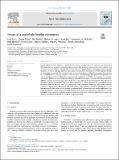Design of a spaceflight biofilm experiment
Author(s)
Zea, Luis; Nisar, Zeena; Rubin, Phil; Cortesão, Marta; Luo, Jiaqi; Moeller, Ralf; Klaus, David; Müller, Daniel; Muecklich, Frank; Stodieck, Louis; McBride, Samantha Ann; Varanasi, Kripa; ... Show more Show less
Download1-s2.0-S0094576517317083-main.pdf (870.0Kb)
PUBLISHER_CC
Publisher with Creative Commons License
Creative Commons Attribution
Terms of use
Metadata
Show full item recordAbstract
Biofilm growth has been observed in Soviet/Russian (Salyuts and Mir), American (Skylab), and International (ISS) Space Stations, sometimes jeopardizing key equipment like spacesuits, water recycling units, radiators, and navigation windows. Biofilm formation also increases the risk of human illnesses and therefore needs to be well understood to enable safe, long-duration, human space missions. Here, the design of a NASA-supported biofilm in space project is reported. This new project aims to characterize biofilm inside the International Space Station in a controlled fashion, assessing changes in mass, thickness, and morphology. The space-based experiment also aims at elucidating the biomechanical and transcriptomic mechanisms involved in the formation of a “column-and-canopy” biofilm architecture that has previously been observed in space. To search for potential solutions, different materials and surface topologies will be used as the substrata for microbial growth. The adhesion of bacteria to surfaces and therefore the initial biofilm formation is strongly governed by topographical surface features of about the bacterial scale. Thus, using Direct Laser-Interference Patterning, some material coupons will have surface patterns with periodicities equal, above or below the size of bacteria. Additionally, a novel lubricant-impregnated surface will be assessed for potential Earth and spaceflight anti-biofilm applications. This paper describes the current experiment design including microbial strains and substrata materials and nanotopographies being considered, constraints and limitations that arise from performing experiments in space, and the next steps needed to mature the design to be spaceflight-ready. Keywords: Bacteria; Fungi; Pseudomonas aeruginosa; Penicillium rubens; Direct laser-interference patterning (DLIP); Lubricant-impregnated surface (LIS)
Date issued
2018-04Department
Massachusetts Institute of Technology. Department of Mechanical EngineeringJournal
Acta Astronautica
Publisher
Elsevier BV
Citation
Zea, Luis et al. “Design of a Spaceflight Biofilm Experiment.” Acta Astronautica 148 (July 2018): 294–300 © 2018 The Authors
Version: Final published version
ISSN
0094-5765